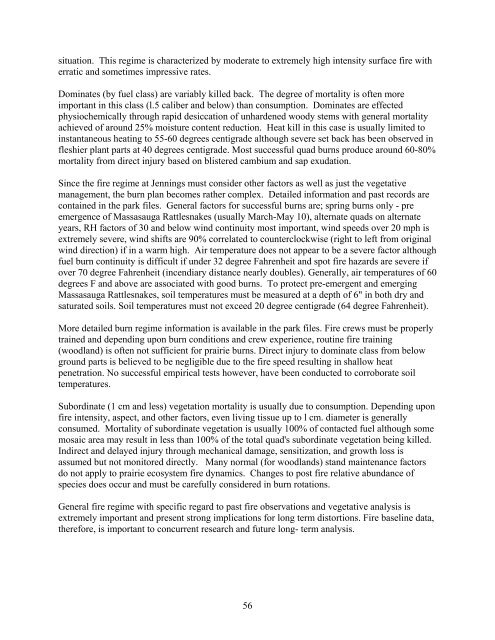The Eastern Massasauga Rattlesnake: - U.S. Fish and Wildlife Service
The Eastern Massasauga Rattlesnake: - U.S. Fish and Wildlife Service
The Eastern Massasauga Rattlesnake: - U.S. Fish and Wildlife Service
Create successful ePaper yourself
Turn your PDF publications into a flip-book with our unique Google optimized e-Paper software.
situation. This regime is characterized by moderate to extremely high intensity surface fire with<br />
erratic <strong>and</strong> sometimes impressive rates.<br />
Dominates (by fuel class) are variably killed back. <strong>The</strong> degree of mortality is often more<br />
important in this class (l.5 caliber <strong>and</strong> below) than consumption. Dominates are effected<br />
physiochemically through rapid desiccation of unhardened woody stems with general mortality<br />
achieved of around 25% moisture content reduction. Heat kill in this case is usually limited to<br />
instantaneous heating to 55-60 degrees centigrade although severe set back has been observed in<br />
fleshier plant parts at 40 degrees centigrade. Most successful quad burns produce around 60-80%<br />
mortality from direct injury based on blistered cambium <strong>and</strong> sap exudation.<br />
Since the fire regime at Jennings must consider other factors as well as just the vegetative<br />
management, the burn plan becomes rather complex. Detailed information <strong>and</strong> past records are<br />
contained in the park files. General factors for successful burns are; spring burns only - pre<br />
emergence of <strong>Massasauga</strong> <strong>Rattlesnake</strong>s (usually March-May 10), alternate quads on alternate<br />
years, RH factors of 30 <strong>and</strong> below wind continuity most important, wind speeds over 20 mph is<br />
extremely severe, wind shifts are 90% correlated to counterclockwise (right to left from original<br />
wind direction) if in a warm high. Air temperature does not appear to be a severe factor although<br />
fuel burn continuity is difficult if under 32 degree Fahrenheit <strong>and</strong> spot fire hazards are severe if<br />
over 70 degree Fahrenheit (incendiary distance nearly doubles). Generally, air temperatures of 60<br />
degrees F <strong>and</strong> above are associated with good burns. To protect pre-emergent <strong>and</strong> emerging<br />
<strong>Massasauga</strong> <strong>Rattlesnake</strong>s, soil temperatures must be measured at a depth of 6" in both dry <strong>and</strong><br />
saturated soils. Soil temperatures must not exceed 20 degree centigrade (64 degree Fahrenheit).<br />
More detailed burn regime information is available in the park files. Fire crews must be properly<br />
trained <strong>and</strong> depending upon burn conditions <strong>and</strong> crew experience, routine fire training<br />
(woodl<strong>and</strong>) is often not sufficient for prairie burns. Direct injury to dominate class from below<br />
ground parts is believed to be negligible due to the fire speed resulting in shallow heat<br />
penetration. No successful empirical tests however, have been conducted to corroborate soil<br />
temperatures.<br />
Subordinate (1 cm <strong>and</strong> less) vegetation mortality is usually due to consumption. Depending upon<br />
fire intensity, aspect, <strong>and</strong> other factors, even living tissue up to l cm. diameter is generally<br />
consumed. Mortality of subordinate vegetation is usually 100% of contacted fuel although some<br />
mosaic area may result in less than 100% of the total quad's subordinate vegetation being killed.<br />
Indirect <strong>and</strong> delayed injury through mechanical damage, sensitization, <strong>and</strong> growth loss is<br />
assumed but not monitored directly. Many normal (for woodl<strong>and</strong>s) st<strong>and</strong> maintenance factors<br />
do not apply to prairie ecosystem fire dynamics. Changes to post fire relative abundance of<br />
species does occur <strong>and</strong> must be carefully considered in burn rotations.<br />
General fire regime with specific regard to past fire observations <strong>and</strong> vegetative analysis is<br />
extremely important <strong>and</strong> present strong implications for long term distortions. Fire baseline data,<br />
therefore, is important to concurrent research <strong>and</strong> future long- term analysis.<br />
56

















